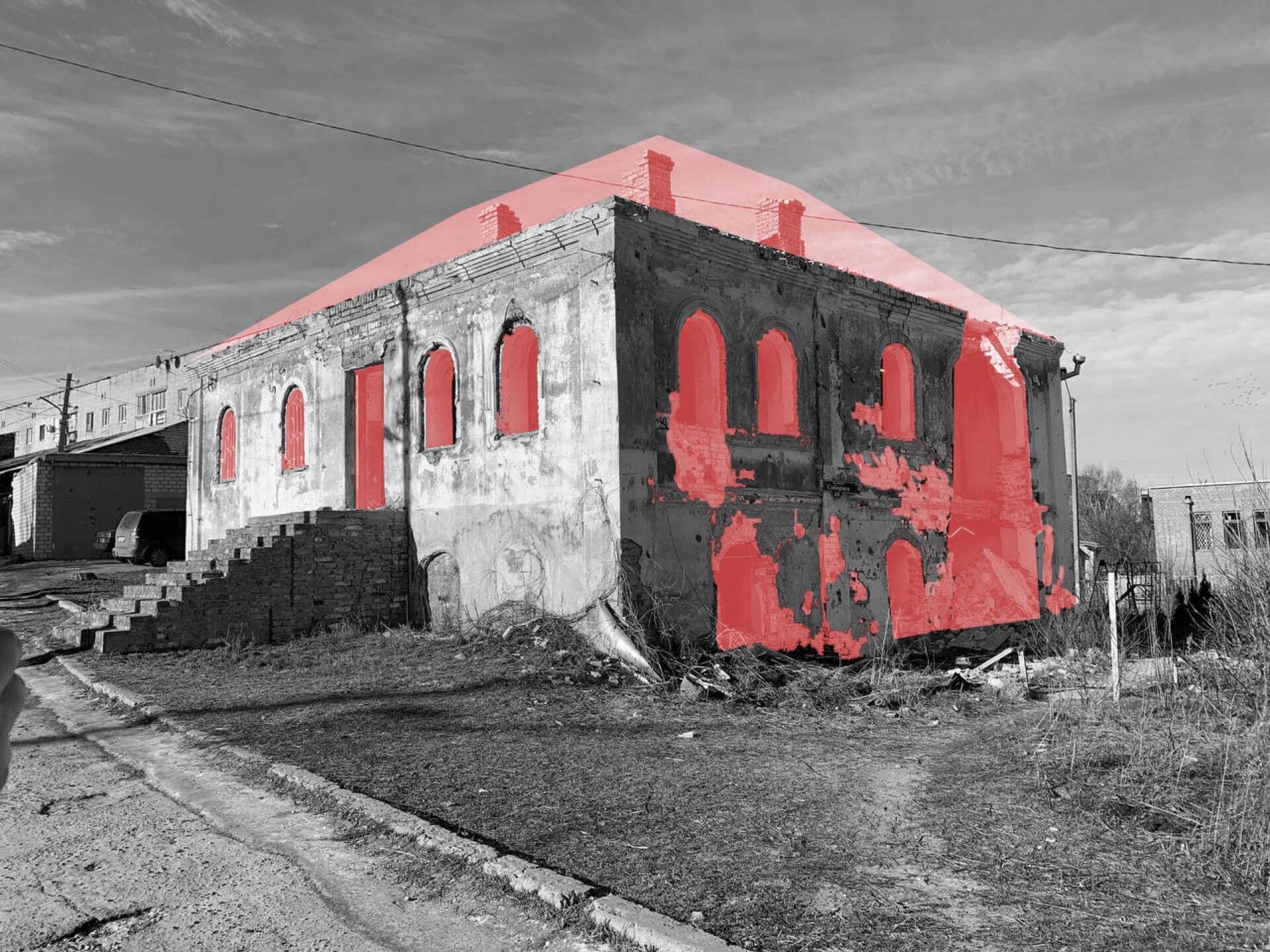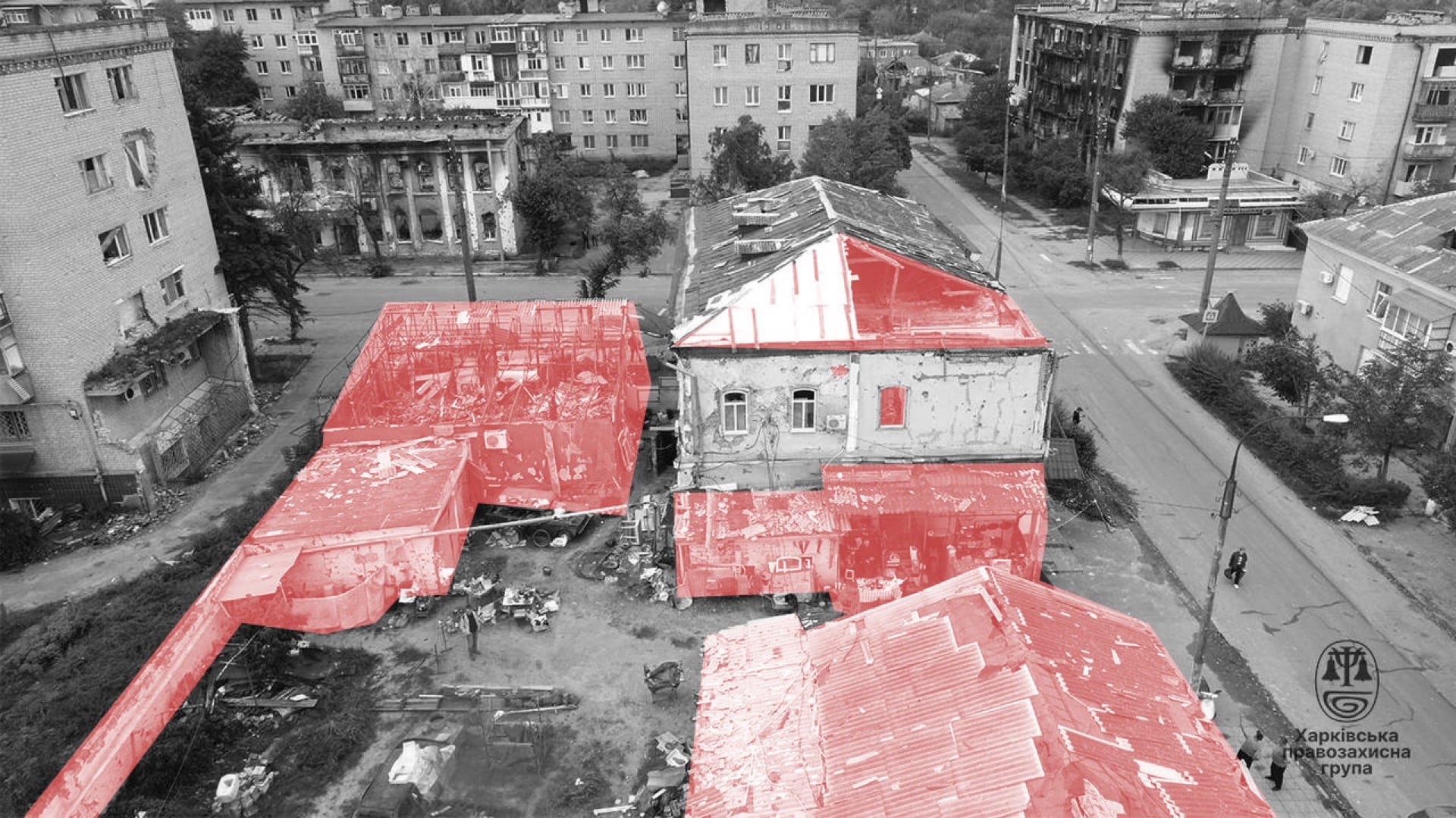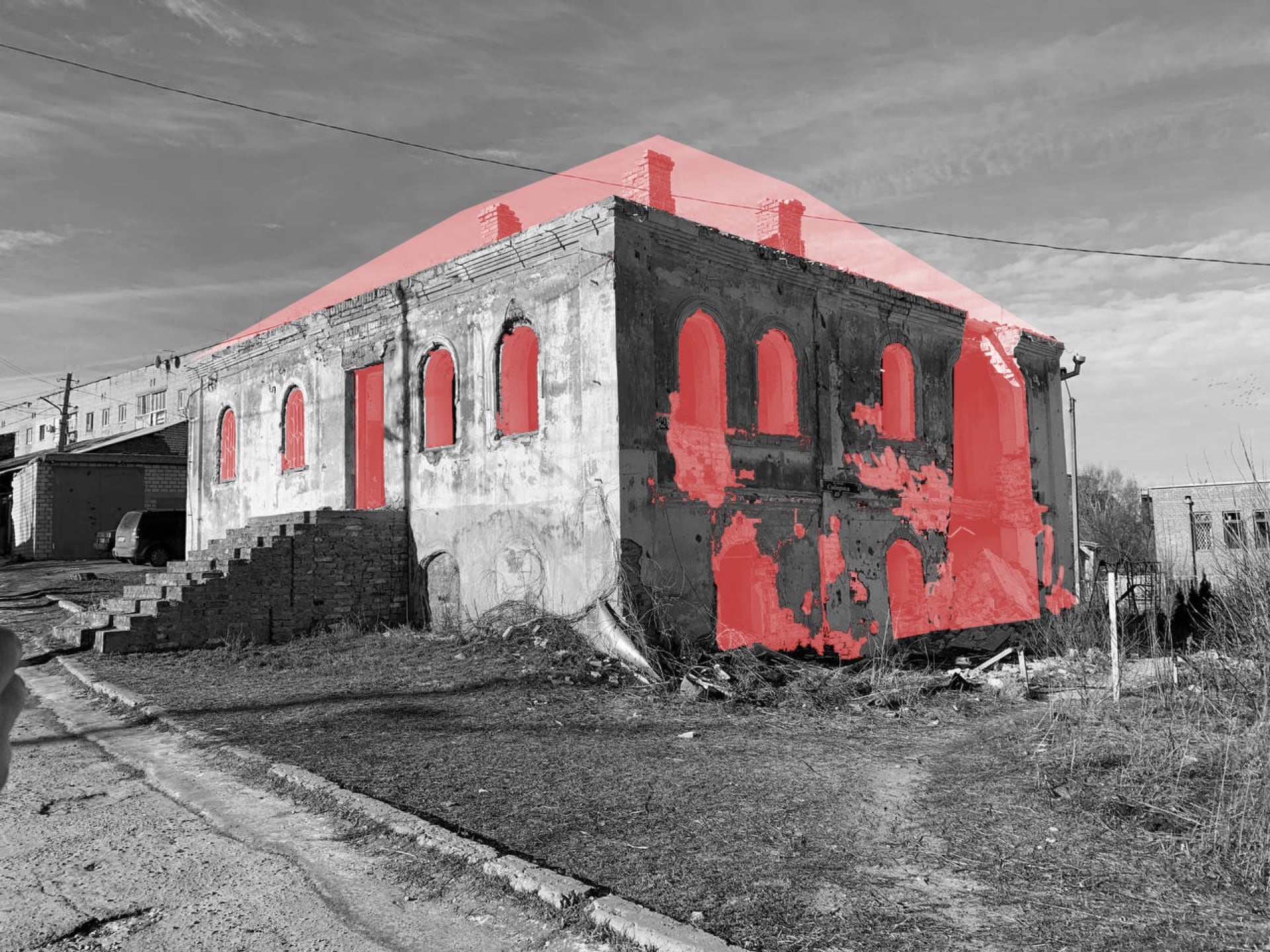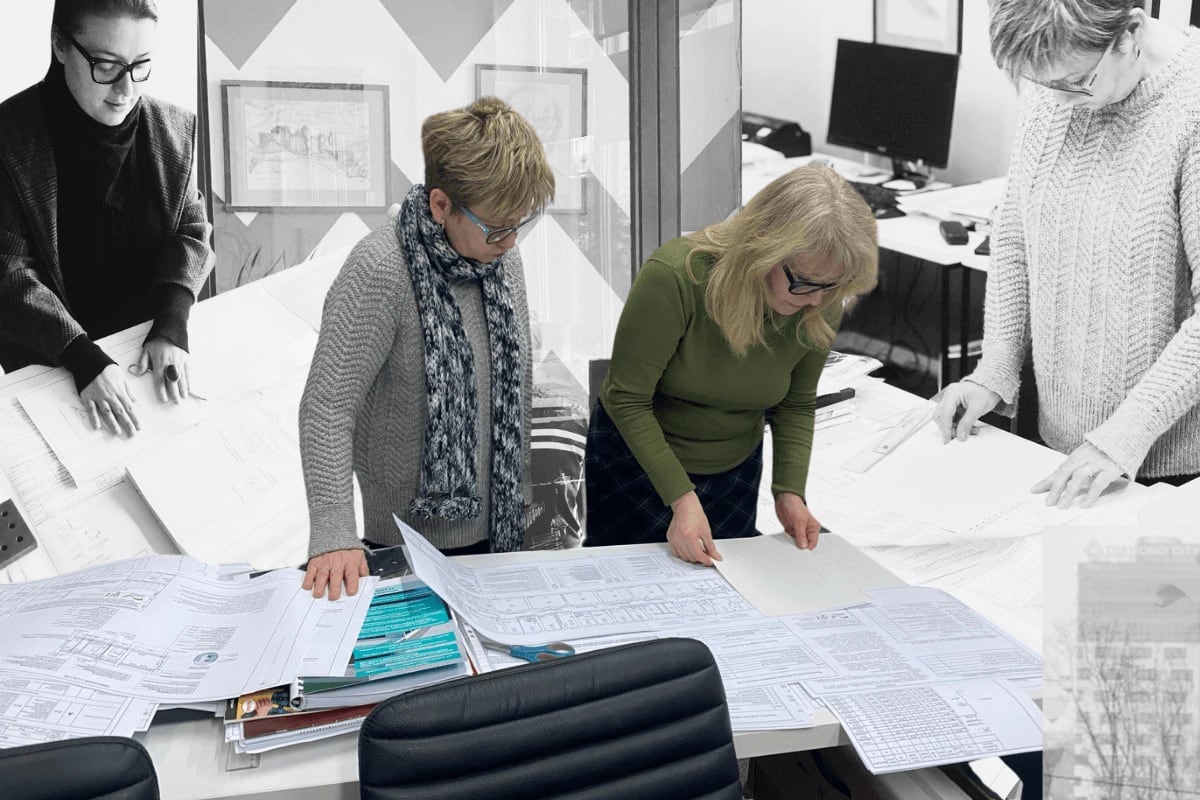ZMINA: Rebuilding - Portal 21 : IZYUM_recovery

Founder of PORTAL-21 Anastasia Hulak on IZYUM_recovery project: “Only together can we recover and continue on the path to victory, the victory of a dynamic society over a static one”
The Russian war in Ukraine has destroyed hundreds of villages and towns including Izyum in the Kharkiv region, which was under Russian occupation for several months in 2022. Nowadays, more and more initiatives are being created in Ukraine that plan to rebuild cities and restore lost buildings. One such project is IZYUM_recovery from the architectural and construction company PORTAL-21.
We talked to Anastasia Hulak, founder of PORTAL-21, about how the architectural company is trying to reconstruct war-torn Izyum, what were the challenges and how did international partners support the project, how they involve local residents in the rebuilding of the city and what makes their project innovative.

What did your team do before the full-scale invasion?
Since 2017, PORTAL-21 Architectural and Construction Company LLC has been engaged in critical infrastructure restoration projects, together with Deutsche Gesellschaft für Internationale Zusammenarbeit (GIZ) GmbH, United Nations Development Program (UNDP), Ukrainian Social Investment Fund (USIF).
We also took on private orders, but these were mostly projects to restore the medical, administrative, and educational sectors.
Your team consists exclusively of female professionals. Tell us about the peculiarities of your team.
Yes, indeed, PORTAL-21 is a 100% female team, with women in management positions and on the company's board. But this does not mean that we do not work with men. On the contrary, we try to enrich the company's experience through inclusiveness, involving experts of different genders, ages, nationalities, and other characteristics. Today, the company is working to develop green management and change behavioral patterns, both within the company and in the projects we develop.
The war has brought many changes, for example, our colleague Kateryna Koval combines her work as a designer with volunteer work. Kateryna is a volunteer medic. At the beginning of the full-scale invasion, she was engaged in psychological support for civilians. For the past year and a half, Kateryna has been an instructor in first aid and tactical medicine for civilians and the military. As a medic, she participated in the evacuation from the frontline areas and in the emergency response team for air raids in Kharkiv.
In 2023, the company's director Kateryna Kublytska took a course on British legislation in the field of monument protection as part of her doctoral dissertation (The Courtauld Institute of Art, London) under a grant from the Samuel Kress Foundation.
And in the same year, in 2023, the company's founder Anastasia Hulak completed a special certified program for young managers, Partnering in Business with Germany, in the field of green management at the Export-Akademie Baden-Württemberg, Tübingen, which is supported by the German Federal Ministry of Economy. Among the women of our company, Zoya Panova is a member of the Union of Architects of Ukraine, who has many years of experience in the implementation of objects of high complexity and is the Chief Architect of the company. Anastasia Shomina, from 2022 to May 2023, upgraded her qualification level in 3D scanning of the historical environment of cities - in the field of scanning monuments of architecture, history and urban planning at The Bartlett School at the University of the College of Architecture in London.
I would also like to note that all the women of our company deal with projects of high complexity that require confirmed qualifications with specialized certificates and licenses, as well as the skills of cooperation with foreign partners and experts, which is especially important now in the context of cooperation with investors from different countries. PORTAL-21 is an example of a sustainable company with a high-flexibility culture that accomplishes important things thanks to the work of a small female team.
How did you come up with the idea for the project you submitted to ZMINA?
The idea for the project came about in July 2023 when the company's founder, Anastasia Hulak, was looking for partners for cooperation in Germany as part of the Partnering in Business with Germany program for managers from Ukraine. The offline part of the program took place in Tübingen, Stuttgart region, and a prerequisite for obtaining a certificate after completing it was to start a new cooperation project with German partners. That is, to sign a cooperation contract. Well, it's not an easy task, especially if we are talking about international cooperation with partners we have not yet met and do not know. Already at the stage of the online part of the program, its managers encouraged us to find a project, a location, and think about which partners could be involved. A great deal of work was done to find suitable grant programs, to find partners, and to select a restoration site. In August 2023, we came across a grant application that was perfect for us. And it was definitely not a coincidence. The application contained all the principles and requirements that we could fulfill. We didn't have to invent anything. We already had partners from Creative Europe, and the project embodied the values of the New European Bauhaus. The only thing we lacked was funding and support from the city administration. So we submitted an application, and at the same time, without waiting for the results, we started a dialogue with the Izyum city administration and the Department of Urban Planning and Architecture of the Kharkiv region to officially provide a plot in the central part of the city for the restoration project. In October 2023, the idea of the IZYUM_recovery project was supported as part of the national wave, and in January 2024, as part of the international wave of subgrants from the ZMINA: Rebuilding program.
In the project, you write that you were inspired by the French Quarter and the Climate Urban District, what exactly interested you in these projects and what do you plan to use in the implementation?
The French Quarter in Tübingen is an extraordinary example of the urbanization of old buildings. In the early 1990s, the French army left Tübingen and abandoned its barracks located in the southern part of the city. In reusing the area and buildings, the city decided to implement an unusual strategy. They wanted to create a mixed-use neighborhood, not only defined as a residential area, but where businesses are integrated into the neighborhood. With the help of citizens, they set up working groups to address different aspects of the new neighborhood, such as life, health, public spaces, etc. To ensure progress, the council set up groups that met with the working groups to advise them and help with their progress. Most of the buildings were founded and built by a community of people rather than individual owners. This concept works so well that it is still used today. People who want to work or live in the neighborhood buy land to build on it together and then, as a group, hire an architect to design their buildings. Getting to know your neighbors beforehand is just one of the many benefits this system provides.
The Climate Urban District is interesting in terms of integrating and using green technologies such as green hydrogen, solar power plants, rainwater harvesting and use, etc. Both districts have about the same area and are located in small towns near rivers, like the city of Izyum. Both are car free districts.
The existing districts contain components that can be adapted in Ukrainian cities and are vivid examples of their implementation and effective functioning.

What is the innovation of the community project?
The innovation is in the participatory approach to design. Where the residents of the neighborhood, together with architects and the city administration, are engaged in reconstruction. This leads to the restoration of not only the neighborhood and its buildings, but also the mental recovery of the residents and all Ukrainians involved in the project. Being involved in the reconstruction process during the war, when everything around us is being destroyed by the enemy, is our manifestation of resilience, which gives us the spirit of victory over the destructive. This approach to the development of urban planning projects may become the most effective of all that have been launched so far. Only together can we recover and continue on the path to victory, the victory of a dynamic society over a static one.
How do you involve the local community in the project?
Residents of the neighborhood help collect baseline data, such as taking photos of damaged areas, collecting data on the necessary materials to be purchased. They participate in the approval of project decisions and coordination of project activities. For example, Oleksii Nestrenko was a community coordinator during the presentation event in Kharkiv. The project also conducts community surveys, which gives us a better understanding of their priorities, attitudes towards the project, relations with representatives of the city administration, and more. The architects created a Telegram channel where we regularly keep in touch, exchange information about the project and its progress. We also have a website where we publish all the news and graphic materials that can be viewed, downloaded, etc. We encourage residents to create a public organization and start acting officially.

What challenges do you face when working on a project?
The project is large, international and requires multidisciplinary expert support and crisis management. And in a time of war, this means increased risks, responsibility, and a constant sense of uncertainty. Therefore, the adaptive nature of the project is a natural and necessary component that strengthens its resilience.
For example, a week before the planned event in Izyum, the city administration sent a letter refusing to support the event - a presentation in Izyum - due to the inability to organize a safe place. So we had to react very quickly and organize a presentation in Kharkiv. Almost until the deadline, we did not know whether we would be able to hold the offline event, but we continued to send invitations and prepare everything for it. And only on the scheduled day, in the morning of May 7 , the venue was confirmed. There are also difficulties related to the change of personnel on the ground. Many people are leaving Izyum for safer places, but whether they will return or not is a big question. So who are we designing for? Will it be safe to live in Izyum in the future? Only time can provide answers to these questions.
Difficulties are also related to the fact that European partners do not visit the project site for security reasons, and this is quite understandable, as Izyum and Kharkiv are in the red zone. Project managers need to spend a lot of time explaining the current situation and the different characteristics of the region and community. Adapting project solutions to the Ukrainian legal framework is also important, as what works in Germany does not always work in Ukraine. Climatic, political, economic, cultural, and social peculiarities are of great importance when developing international cooperation projects.
Did you face any difficulties in the beginning of your work related to project support? How did you solve it?
As for the difficulties of support, I would say that there are no difficulties so far, but when it comes to paperwork, there is already some resistance. And when you get down to business, it's a different matter altogether. At the moment, we are supported by the Kharkiv Regional Military Administration, which has provided premises for the project's events and is promoting the project by signing important documents and providing initial data for its development. However, we expect more active actions from the Izyum administration in terms of supporting and motivating the community and other activities envisaged by the project, as well as from the residents of the neighborhood themselves. Because this small group of activists should grow, and this is also the responsibility of local administration representatives.
What events have already taken place within the project?
The project has already held 5 events:
On April 10 2024 , a webinar on "ADAPTIVE STRATEGIES FOR SUSTAINABLE CITY DEVELOPMENT" was held. The lecturer was Prof. Christian Küpfer, Head of the Institute for Landscape and Environment (ILU) at the University of Nürtingen-Hesse in 2011 - 2013 and Dean of the Landscape Planning and Nature Conservation Study Program from 2013 to 2018, Ecology and Urban Planning at the University of Nürtingen-Hesse, author of numerous projects and publications on ecology and urban planning. Today, he is the head and founder of StadtLandFluss, where, under the leadership of the professor, government contracts are successfully implemented in the state of Baden-Württemberg.
On May 7 2024 , we held a high-level presentation of the project with an online broadcast function involving: the ZMINA: Rebuilding project team, the press, community representatives, investors, performers, and other stakeholders, with the event broadcast on YouTube. The format of the event was hybrid - online and offline in Kharkiv.
The next day we had networking with partners from Ukraine - online and in Kharkiv.
We also presented the project at the TEH97 conference in Tartu, Estonia.

You are also planning to organize exhibitions in Ukraine and Germany, tell us more about this: what is the goal, how will they be held?
The purpose of the exhibitions is to draw attention to the project, its values, and adaptive nature. To its inclusiveness and to involve new stakeholders in its development. It is also very important to raise funds for the priority work that needs to be done in the neighborhood so that residents can spend the next winter in warm and dry homes.
In Tübingen, the exhibition is planned to be held in the French Quarter, which is one of the examples we have chosen with our partners to analyze as an example of successful community development through involvement in the restoration of abandoned areas.
In Kharkiv, the exhibition will be held at the Art Center. The exhibition formats are hybrid with online broadcast and translation. We also plan to organize panel discussions as part of these exhibitions and invite experts on sustainable urban development, stakeholders, and investors as speakers.
At what stage is the project now?
The project is currently at the stage of developing the draft design. Planning of residential buildings, adaptation to inclusive needs and standards. Development of a master plan and reconstruction of completely destroyed housing, collection of necessary baseline data, involvement of environmental experts. Analyzing existing examples of community development and green technologies. Preparing events to be held within the project this year.
Do you plan to expand the project to other cities in Ukraine?
Yes, we plan to do this in the future.
Author: Anna Siedykh
ZMINA: Rebuilding is a project co-funded by the EU Creative Europe Programme under a dedicated call for proposals to support Ukrainian displaced people and the Ukrainian Cultural and Creative Sectors. The project is a cooperation between IZOLYATSIA (UA), Trans Europe Halles (SE) and Malý Berlín (SK).
